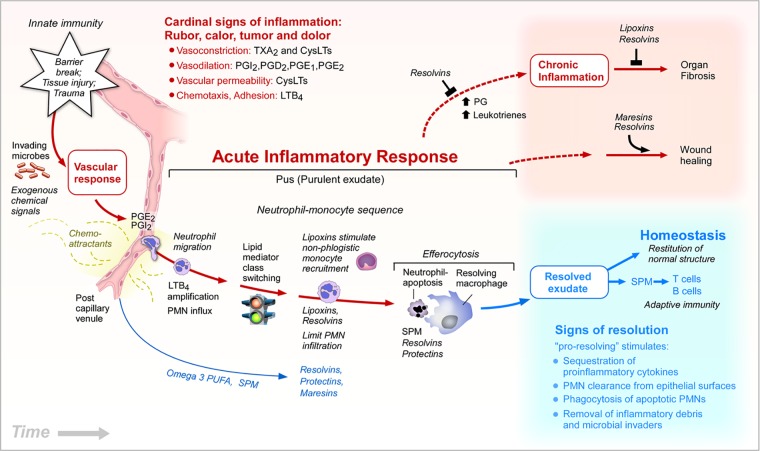Figure 1.
Eicosanoids and proresolving mediators in the inflammatory response. Time-course illustration of the key roles of lipid mediators in the initiation and resolution of acute inflammation. Eicosanoids function and contribute to cardinal signs of inflammation. Prostaglandin E2 (PGE2) and PGI2 permit neutrophils to transmigrate from postcapillary venules across endothelial cells to migrate and chemotax along a gradient of leukotriene B4 (LTB4), a potent chemoattractant. Lipid mediator class switching occurs as neutrophils congregate in pus or purulent exudates (see text and ref. 34 for details). Lipoxins (LXs) stimulate nonphlogistic monocyte recruitment. LXs, resolvins (Rvs), and other specialized proresolving mediators (SPMs) are produced in pus to limit or stop further neutrophil tissue infiltration. SPMs, Rvs, maresins (MaRs), and protectins, each stimulate efferocytosis of apoptotic neutrophils and cellular debris by macrophages. Resolving macrophages and apoptotic neutrophils also produce SPMs (see ref. 135). Edema also brings circulating n-3 polyunsaturated fatty acids (PUFAs) [eicosapentaenoic acid (EPA) and docosahexaenoic acid (DHA)] into exudates for temporal conversion to SPMs by exudate cells (85). SPMs stimulate the signs of resolution and resolve exudates (33). Rvs and SPMs block chronic inflammation and reduce fibrosis. MaRs and specific Rvs enhance wound healing and tissue regeneration.

